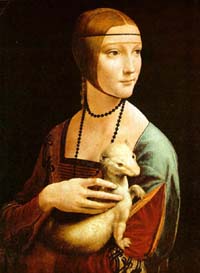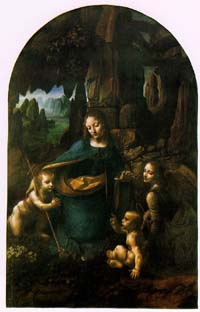|
Darkness is pressing
down on the appreciation of art, and both historians
and scientists are to blame. Look at these examples:
In his new book Becoming
Mona Lisa: The Making of a Global Icon, Donald Sassoon
says that the modern popularity of the portrait's mysterious
smile is the result of constant discussion about it, which
makes Sassoon part of the problem. In writing about the
"enigmatic smile," he keeps our focus on it, as if that
were all the painting is about. But more about that in
a moment.
Last year, neuroscientist
Margaret Livingston said in a New York Times story
that the smile seems fleeting because of the way our eyes
and brains compute light and dark. If you're looking at
the eyes with peripheral vision, she said, you pick up
shadows from the cheeks that suggest a smile. But there
is no such suggestion if you look directly at the mouth—which
is as inconsequential as saying that if you look at an
Impressionist painting too closely, all you see are paint
smears.
Pooh-poohing the Livingston
theory—and all others, for that matter—is Frederico
Zeri, art history professor at Catholic University in
Milan. In his book Behind the Image, he concludes
that the smile is simply the effect of innumerable coats
of varnish and dirt beneath the surface and that if the
painting were cleaned, the mystery of Mona would disappear.
In 1999, Carlo Pedretti,
director of the Armand Hammer Center for Leonardo Studies
at the University of California, announced that all of
Leonardo’s paintings were based on sculpture. He
got this from Renaissance sculptor Benvenuto Cellini,
who wrote that Leonardo sculpted clay models of his subjects
before painting them. It’s odd that Pedretti would
cite the words of Cellini, who was barely 15 years old
when Leonardo resettled in France, away from where Cellini
grew up, and not cite Leonardo, who wrote: "The lines
of perspective of sculptures do not seem in any way true.…
They can represent neither mists, nor dull weather, nor
an infinite number of things…."
In 1996, in historical
fiction, Rina De' Firenze suggested that the model for
Mona Lisa was Leonardo's mother, Caterina. Why?
Just a premonition, said the author—that and repeated
visions of the artist's mother urging her to tell this
to the world. No less silly is the theory of Dr. Lillian
Schwartz of Bell Labs, a pioneer in computer graphics
and computer art. She said that Mona is really Leonardo.
By digitizing the features of both Leonardo's face and
Mona's and merging them, she said, they line up. I feel
a "so what?" coming on. How about you? I mean, if the
smile in the portrait is good for anything, it's not because
of a likeness to one person over another.
In 1959, Dr Kenneth D.
Keele wrote in a medical journal that Mona was pregnant.
How could he tell? The maternal calm of her smile, dummy.
 |
|
Lady
with an Ermine
|
Okay, let's get into it.
You want to talk about that smart-ass little grin that
never reaches Mona's eyes, that starts at the edge of
her mouth, flickers and then dies, as if she decided to
unsmile? To hear historian Henrik Willem Van Loon tell
it in his book The Arts, her mouth is firmly set
that way, rendering her strand-like lips indistinct as
they merge into soft shadow because Leonardo didn't paint
lips very well. Van Loon points to the same mouths in
Leonardo's other portraits of women, Madonna and Child
with St. Anne and Lady with an Ermine. In fact,
all of his likenesses of women show the same features:
heavy lids, pointed chin and balanced face, which suggest
these were his ideals. Van Loon also said that the so-called
smile can be seen in numerous ancient sculptures, which
he contends is due to the same thing that plagued Leonardo:
an inability to render mouths.
So, you ask, how can such
a gifted draftsman have trouble with mouths? Van Loon
has a ready answer. There's a big difference between drawing
and painting, he says—that and the fact that Leonardo
was not a disciplined painter. He seldom finished a picture,
which accounts for the paltry number he left behind.
You can talk about Mona
Lisa as a portrait all you want. But it's less a likeness
and more a landscape, and no one in the art-hype business
seems to notice that. Just look in the distance, and you'll
see the sort of place that would make a Martian feel at
home: rocks, rocks and more rocks. Beyond the scrim of
dewy-edged Mona is alpine scenery cloaked in a velvety
mist, and, if you ask me, it’s more haunting than
she is.
 |
|
Virgin
of the Rocks
|
Leonardo gets it so right,
you can almost smell the pungent river air. He painted
this same backdrop in his other figure paintings, such
as The Last Supper and Virgin of the Rocks.
The rugged terrain is said to be the view of his hometown,
Vinci, where the River Arno enters a gorge. His first
known drawing was of the Arno landscape. Apparently, then,
it was his field of dreams, not Mona.
So here's this quiet, oval
face like stone, and it's just one of many stones that
roar up from a faraway river. Her arms show the way. Folded
tight as a gate, they are an entry to what lies beyond.
What do historians have
to say when they actually get around to mentioning the
landscape in Mona Lisa? In 2000, Carlo Starnazzi,
a University of Florence paleontologist, told the Italian
media that the rocky mountains in the background of Leonardo
da Vinci's St. Anne, Madonna and Child are not
a product of the painter's imagination but, rather, a
direct copy of a region in the Tuscan Appennines known
as the Balze. This is the same thing Starnazzi said about
Mona Lisa some five years earlier—that the
misty lake, jagged mountains and winding river behind
Leonardo's Mona are copies
of a landscape in eastern Tuscany.
But, hey, so what? Does
it matter to the eye that the waterway to the left is
Lake Chiana, the winding waterway to the right is a canal
that links the lake with the Arno River, the bridge is
the medieval Burgiano Bridge and the mountains are Tuscany
hills?
And why should we believe
that an artist who can invent flying machines had to copy
his subject in order to paint it? Leonardo seems to answer
this in his Treatise on Painting: "If the painter
wants to survey vast stretches of the country... he has
it first in his mind and then in his hands.'' Painting
is "una cosa mentale,'' a mental thing, he said. That
said, it's hard to picture him setting up his easel in
the Tuscany grassland to render the background in the
portrait.
And because the details
in this background disappear in the misty atmosphere,
clearly Leonardo wanted viewers to see more than geography.
He was not a naturalist. He painted mood, the undefined
and the ambiguous. He used sfumato technique (blurring
edges), as if he breathed the paint rather than brushed
it. In Mona Lisa, he painted the land that he loved.
And by the romantic air of mist, he seemed to want us
to love it, too.
No such luck. The lights
are fading, and the game is lost. Historians and scientists
are getting in the way. Down in front, I say. You're spoiling
the view.
|